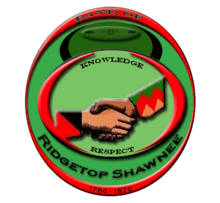Ridgetop Shawnee

The Ridgetop Shawnee Tribe of Indians descend from southeastern Kentucky's early multiracial settlers of 1790-1870. Their ancestors migrated to the central Appalachian region in the late 18th to mid 19th centuries.[1] The Ridgetop Shawnee Tribe of Indians are the only Native American tribe to have been recognized and honored by a body of the Kentucky General Assembly. In 2009 and 2010, resolutions by the State House of the Kentucky General Assembly recognized the Ridgetop Shawnee Tribe of Indians for their care of their children and elderly, and their work to preserve their culture and Native American heritage in the region, including prehistoric sites. In June 2013 the Pine Mountain Indian Community, LLC, announced that the Ridgetop Shawnee Tribe of Indians would become the heritage arm of this nonprofit organization. Within this new management structure the Ridgetop Shawnee Tribe of Indians will concentrate more on the heritage of the region while the Pine Mountain Indian Community will take the lead with regard to economic development and community development in Southeastern Kentucky.
Historical claims
In the late 18th to mid-19th centuries many multiracial families, of Native American, European and African heritage, migrated to southwestern Virginia; extreme southeastern Kentucky, particularly Harlan County; and northeastern Tennessee. In the 1870 federal census for Harlan County, for instance, numerous families were identified as Indian, and more have had that family tradition, such as Sizemore, Callahan, Eldridge, Cole and others.[2] Often such families moved to the frontier for less expensive land, as well as to avoid racial discrimination in more settled areas of slave states. Remnant members of tribes intermarried with their neighbors and a multiracial group of settlers formed.
Modern achievements
The Ridgetop Shawnee Tribe have worked to strengthen and preserve Native American traditions and culture. They contributed to passage of local ordinances that prohibit digging, or artifact hunting, on county and city lands. One such ordinance was passed by the Harlan County, Kentucky fiscal court in 2006. The only such ordinance in the Commonwealth of Kentucky, it has decreased illegal artifact hunting and helped preserve prehistoric sites. The Ridgetop Shawnee Tribe of Indians were instrumental in the creation of the Harlan County Native American Site Protection Office.
The group members work with state, city and county officials to protect Native American cultural resources in Eastern Kentucky. They gained agreement from the city of Ashland, Kentucky to put a protective fence around prehistoric earthworks in a park; a site listed on the National Register of Historic Places as the Indian Mounds in Central Park.[3]
In addition, the tribe has developed a database of documented Native Americans in southeastern Kentucky, southwestern Virginia and northeastern Tennessee, to make it easier for other persons to trace their ancestry. By December 2011, the Kentucky Native American Databank held basic genealogical data for more than 1,000 names; it is hosted on the free genealogy site, Rootsweb.[4] The tribe is seeking to preserve the Shawnee language, a Central Algonquian language that was traditional for many of its ancestors. Today it is spoken primarily by Shawnee in Oklahoma.
In 2009 and 2010, the State House of the Kentucky General Assembly recognized the Ridgetop Shawnee Tribe of Indians by passing, unopposed, House Joint Resolutions 15 or HJR-15 in 2009 and HJR-16 in 2010.[5][6] These acknowledged the people's long history in the state, its efforts to preserve Native American heritage, as well as to help its elderly and young people.
Membership
The Ridgetop Shawnee require that prospective members prove documented descent from multiracial settlers in the region from 1790–1870, and also have Y-DNA or MtDNA showing direct-line Native American ancestry. Y-DNA and or MtDNA may only be used to show descent from documented individuals who are eligible for enrollment.[7] In 2012 the Ridgetop Shawnee began the Express Enrollment program for descendants of several family lines of mixed-Native American heritage, who have been well-documented as migrating to Southeastern Kentucky, Northeastern Tennessee, and Southwestern Virginia in the late 18th and early 19th centuries. These families and lines are: Sizemore (KY), Fields (KY, VA), descendants of Hawkins Bowman (KY, VA), descendants of Ezekiel Bennett (KY, TN), descendants of John Cole (KY, VA) and descendants of Porter Jackson (KY, VA).[7] In June 2012, the tribe limited enrollment to individuals who qualified to use Express Enrollment.
Historical Shawnee people
Europeans reported encountering Shawnee over a widespread geographic area. The earliest mention of the Shawnee may be a 1614 Dutch map showing the Sawwanew just east of the Delaware River. Later 17th-century Dutch sources also place them in this general location. Accounts by French explorers in the same century usually located the Shawnee along the Ohio River, where they encountered them on forays from Canada and the Illinois Country.[8]
References
- ↑ Ridgetop Shawnee Tribe of Indians Website
- ↑ Holly Timm (3 June 1987). "Indian Blood Runs in Many Harlan County Families". Harlan Daily Enterprise.
- ↑ Carrie Stambaugh (4 July 2009). "Mounds will be fenced off from public". Daily Independent (Ashland, KY). Retrieved 15 January 2012.
- ↑ William Shackleford, "Kentucky Native American Databank", Rootsweb, accessed 15 January 2012
- ↑ "Kentucky General Assembly 2010 Regular Session HJR-16". kentucky.gov, updated 9-2-2010.
- ↑ "Kentucky General Assembly 2009 Regular Session HJR-15". kentucky.gov, updated 5-2-2009.
- 1 2 Ridgetop Shawnee Tribe of Indians, Official Website
- ↑ Charles Augustus Hanna, 1911 The Wilderness Trail, esp. chap. IV, "The Shawnees", pp. 119–160.